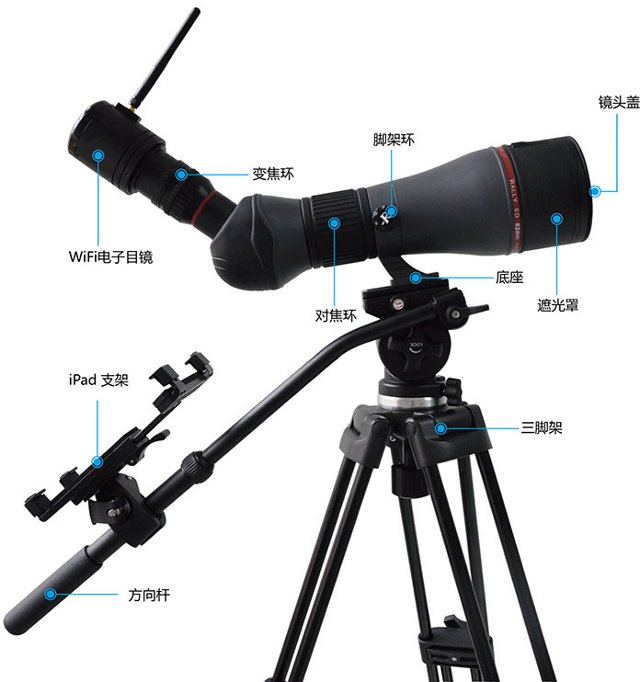Ostec Electro-Optical Science and Technology, is a company headquartered in Shenzhen, China, with a factory based in Guangzhou, that manufactures optical devices such as telescopes, microphones, endoscopes, and scanners that connects to your computer, or tablet via USB or Wi-Fi. Charbax of armdevices.net interviewed the company in April at the Hong Kong Electronics Fair, and uploaded the video (see bottom of post) very recently. Let’s have a closer at some of the products. KoPa WiFi Telescope (Model TW501) The first device is TW501 Wi-Fi telescope that comes with a tablet holder, and allows you to visualize the picture directly on your smartphone, tablet, or other Wi-Fi capable device either via specific Apps or via the web browser. It apparently not suited for astronomy, but can be used for bird watching, building surveillance, hiking, and any application where you may need to take close-up pictures or videos. Wi-Fi Telescope Specifications: Sensor […]
Adding a Project to Gitorious with a Windows Computer
If you are developing software in Windows XP, Windows Vista or Windows 7, here are the steps to follow to push your project to Gitorious. Register and create a new project on Gitorious, if you haven’t done already. Install msysGit to have git on your Windows machine Click on “Git Bash” to start the command line Generate the SSH Key with “ssh-keygen -t rsa” and press ‘Return’ in every question. Go to your Gitorious dashboard, click on “Manage SSH Keys” then “Add SSH Key“, copy the content of “cat ~/.ssh/id_rsa.pub” in Gitorious and click save Then go to your local project directory and follow the “getting started instructions” given in Gitorious, which should look like: git config –global user.name “Your Name” git config –global user.email “[email protected]” git checkout master git remote add origin [email protected]:your-project/your-project.git git push origin master Then wait until the code is pushed to the Gitorious server. If […]
Twitter Timeline in Thunderbird 3.x
I’ve just found an experimental Add-ons for Thunderbird 3.1 that allows to get your twitter timeline in Mozilla Thunderbird. Experimental means that it has not been verified by Mozilla. The add-on is called TweeQuilla. You can download the xpi: tweequilla-0.1-tb-win.xpi. Then install it in Thunderbird: Open Add-ons from the Tools menu, click the Install button, select tweequilla-0.1-tb-win.xpi and click OK. Then to enable a Twitter Account to go Tools->Account Settings->Account Actions->Add Twitter Account. The Add Twitter Account dialog box will appear: Then click on Click Here First, login to twitter and allow it to be accessed by this application. A pin will be given enter the pin and click OK. That’s it ! You should know have a Twitter Account in Thunderbird and can access your Timeline as shown below. It will even automatically load the short URL inside Thunderbird. You can allow send tweets using the Write button as […]
Detecting Code Duplicates in C/C++ with CCFinderX
Over time, as your source code repository and software team(s) grow, you may have more and more code that just does the same thing. This is obviously not desirable since several persons work on code doing the same thing, so you just pay twice for the cost for development and debugging. To avoid this issue, proper team communication and management must be in place (e.g. discourage copy/paste of source code, use a common source control repository..). However, it might be difficult to always detect where the code duplicates are. Luckily, code duplication analysis tools such as CCFinderX are here to help. As described on CCFinderX website: CCFinderX is a code-clone detector, which detects code clones (duplicated code fragments) from source files written in Java, C/C++, COBOL, VB, C#. CCFinderX is a major version up of CCFinder, and it has been totally re-designed and re-implemented from scratch. Its new design and […]
EP9307 Thin Client with DirectVNC
One of my reader had issues running Thin-clients ENTC Encore-1000 based on EP9307 and wanted to update the firmware in his systems. So I’ll explain how to access Linux, Windows XP or any other operating systems using a thin client based on Cirrus Logic EP9307 hardware. This is for reference only, and the performance may not be suitable for your environment/setup. One PC (server) is needed to run VNC (Virtual Network Computing) server for each remote desktop (i.e. each thin client), then the thin client can run the software without hard disk by just using the network connection. This can be used for checking emails, browsing internet, office applications, etc.. All resource heavy tasks are done on the server side whose specifications may be chosen to match the applications requirements. I’ll explain how to use Linux, but Windows XP (or any other operating systems for that matter) could also be […]





